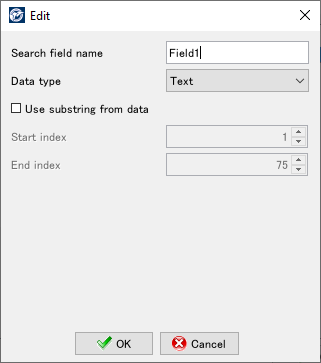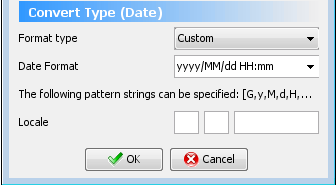Field properties ("General" tab)
Set the properties in Property editor. Field properties are grouped into the General, Report-writer, and Multi-page tabs.
This section describes the General tab of the field properties.
Reference
In the column where you specify a color, you can select any color registered as a palette color in Settings - Palette color settings.
Setting items in the "General" tab
Properties | Description |
|---|---|
Name | Type a field name. If you do not specify a field name, it is automatically and sequentially specified from "Field1". You can use alphanumeric characters, Kana, Kanji, and underscores (_). Do not use a number for the first character of a field name. Names with ten or more bytes of consecutive numeric characters cannot be used. The maximum length of the name depends on the setting in Preferences. |
Comment | Type comments for the field. Although comments are not used for printing, you can easily manage forms by including the field description in the comments. Also, you can set the FFEject feature by entering "/{FFEject=1}/" in comment. For details of FFEject, see "FFEject". |
Link-field name | Specify a link-field name. The link-field is a field that takes over the excess data and prints it when data that exceeds the number of printable digits in this field is received. If you do not specify a link-field, excess data will be cut. For a field created within a record, you can specify the name of the field itself in Link-field name to enable auto-break. Such fields are called "auto link-fields". Reference
CautionYou can specify a link-field for text fields only. RestrictionIf you output a form in Thai, a line feed using a link field does not consider a combination of consonants, vowels, and tone marks. |
Graphic mode | Specify whether to enable the graphic mode. Select to enable the graphic mode and make the extended settings available. ReferenceThe Graphic mode is displayed in Property editor when Enable graphic mode is selected in Preferences - Operation mode. However, even when Enable graphic mode is cleared, the Graphic mode field appears for items that have already been designed in the graphic mode. |
X(dot) | Specify the X coordinate of the upper left corner of the field. For a vertical writing field, the X coordinate represents the upper right corner in the graphic mode and the upper left corner in the basic mode. |
Y(dot) | Specify the Y coordinate of the upper left corner of the field. For a vertical writing field, this value represents the Y coordinate of the upper right corner. |
Number of digits (print) | Specify the number of characters to be printed in digits. If you want use the FORMAT function in the edit-formula to output data that includes a decimal point, commas, or additional symbols, you need to specify the total number of digits including the byte size of the decimal point, commas, and additional symbols. ReferenceYou can change the number of digits by dragging the black handle that appears at the four corners of a field when you select the field. CautionIn numeric fields, all digits are filled with asterisks (*) when the output data exceeds the number of digits specified for the fields. |
Number of digits (data) | Specify the data buffer size for the field in bytes. Specify this setting when you want to retain data that is larger than the number of printable digits in order to process a calculation-formula and/or edit-formula. If "0" is specified, the value for this field is considered the same as Number of digits (print). When the field is set as an auto link-field, the value set here is considered the upper limit for auto-break. If Number of digits (print) is set to 20 digits and Number of digits (data) is set to 100 digits, up to five lines are output with line-feed. |
Field type | Specify whether the data to be input in the field is half-width or full-width. The purpose of this setting is to allow you to see easily in the form window whether the data set in the field uses half-width or full-width characters. This feature does not convert full-width into half-width characters or vice versa when printing them. Even when you specify half-width, double byte characters are still output without any problems. |
Pitch(dot) | Specify the character pitch. This is for the pitch between half-width characters. For full-width characters, the pitch is double the value specified here. |
Fixed pitch | Usually, all characters are output character-by-character. However, if you select this item, characters are output as a string under some conditions. (Some printer models do not support this feature.) This operation is available for the SATO global model, the Zebra model, or certain printer models that have a maximum limit on the number of characters that can be output. You may be able to use the printer-specific features by selecting this item. However, in some cases, characters may not be output at the correct positions. |
Full-width font | Select a font used to print full-width characters. You can select from the fonts that appear in the drop-down list. When fonts have been added in Settings - Preferences - Font selection, only fixed pitch TrueType fonts will appear in the drop-down list in the basic mode. In the graphic mode, proportional fonts will also appear. |
Half-width font | Select a font used to print half-width characters. You can select from the fonts that appear in the drop-down list. When fonts have been added in Settings - Preferences - Font selection, only fixed pitch TrueType fonts will appear in the drop-down list in the basic mode. In the graphic mode, proportional fonts will also appear. If you select None, fonts specified as full-width characters are also used for half-width characters. |
Font size | Specify the font size to be printed in the range of 1 to 96 points. |
Data type | Specify whether the data output in the field is processed as numerical value or as text. ReferenceThe default value of the field buffer varies depending on the data type of the field.
|
Edit style | Select the alignment style for printing data in the field.
|
Calculation-formula | Set a calculation-formula in the Calculation-formula dialog displayed by clicking the ... button in the Calculation-formula field. You can set the edit functions provided in SVF, such as basic arithmetic operations or field references. |
Edit-formula | Set an edit-formula in the Edit-formula dialog displayed by clicking the ... button in the Edit-formula field. You can use editing functions and system variables provided by SVF, and set the data output format using the FORMAT function. ReferenceThe buffer values of fields where calculation-formulas or edit-formulas is specified vary as follows:
|
Attribute-formula | Click the ... button in the Attribute-formula to set an attribute-formula in the Attribute-formula dialog displayed by clicking theAdd button in the Attribute-formula dialog. For items placed on pages other than Common, you can set display attributes, such as whether to show or hide it and text colors, by specifying with functions. |
Use as search field | Specify whether to use the field as a search field in SPA. When you select the check box, the search field information is added to PDF files that are output with SVF for PDF. SPA uses the added information as search conditions or smart-split conditions. For details, see the product manuals for SPA. Caution
|
Search field | If you select the Use as search field check box, specify a search field name. The setting items vary depending on the settings of Data type and Graphic mode. The initial value is set to the same name as the field Name. You can use alphanumeric characters, Kana, Kanji, and underscores (_). Do not use a number for the first character of a search field name. Names with ten or more bytes of consecutive numeric characters cannot be used. The maximum length of the name depends on the setting in Preferences.
|
Vertical magnification, Horizontal magnification | Specify the height and width ratio of characters. In the basic mode, you can only specify the magnification from 0.5, 1, 2, 3, 4, 6, or 8. RestrictionSupported scaling combinations may be limited depending on the printer model. |
Text direction | Select the print direction as vertical or horizontal. |
Rotation angle | Specify the rotation angle to rotate the string. In the basic mode, you can specify 0, 90, 180, or 270. In the graphic mode, you can specify any value between -360 and 360. The string is rotated counter-clockwise when you specify a positive value and clockwise when you specify a negative value. If the text direction is horizontal, the string is rotated around the upper left corner coordinates. If the text direction is vertical, the string is rotated around the upper right corner coordinates. In graphic mode, you can rotate the item using the handles. For details, see "To rotate a field". |
Mask | You can set a mask to disable printing of the field data. Set this option for items such as dummy fields used only as key-breaks (used only for data processing without printing). When selected, the field is masked (the data is not printed). When cleared, the field is not masked (the data is printed). |
Bold | Select to output the characters in bold. |
Italic | Select to output the characters in italics. |
Outline | Select to outline output characters. |
Outline width(dot) (Only in graphic mode) | When Outline is selected, set the line width in dots when outlining characters. |
Mask/Image (Only in graphic mode) | When the Outline check box is selected, specify an image to output in the area enclosed by the outline. |
White-letter | Select to output characters in white. |
Shadow | Select to output characters with shadows. RestrictionThe specified character decoration may not be output depending on the model. |
Gradation (Only in graphic mode) | Select to display text using a gradation color. |
Gradation start color | When Gradation is selected, specify the start color of the gradation. |
Gradation end color | When Gradation is selected, specify the end color of the gradation. |
Gradation type | When Gradation is selected, specify the direction of the gradation from the start point to the end point. The gradation changes depending on the start color, the end color, and the type as follows: 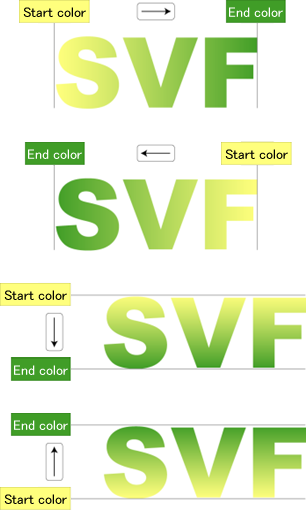 |
Bookmark level | When using the bookmark feature of a PDF file, specify the bookmark hierarchy number in the range of 0 to 9. |
Extended auto link mode
By using extended auto link mode, the output of data that has overflowed the page can be continued after a page break.
The values and descriptions for each mode are as follows. In SVF Cloud, "3 (extended auto-link mode 3)" is applied.
Value | Description |
|---|---|
0 (normal auto link) | Extended auto link mode is disabled, and operation is as before. If the auto-link field in the record does not fit within the page, output cannot be continued on the next page after a page break. 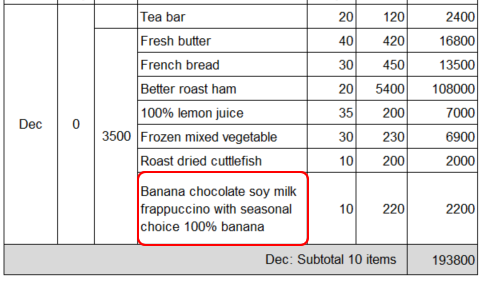 |
1 (extended auto link mode 1) | If an auto-link field in the record does not fit within the page, it will be output at the beginning of the next page. If the data still does not fit inside that page, only the part that has overflowed the page will be output on the next page. To set this mode,clear Forced print in the record properties of total records and grand total records. 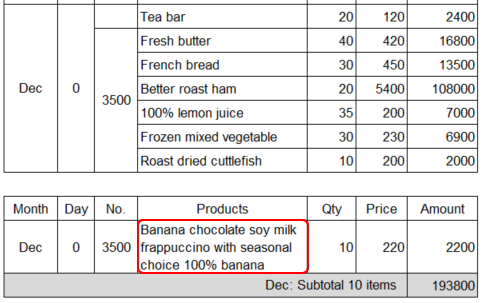 |
2 (extended auto link mode 2) | For the auto-link field in the record, only the part that does not fit within the page will be output on the next page. Note that header records and total records will be output at the beginning of the next page if everything did not fit inside the page (same as 1). To set this mode,clear Forced print in the record properties of total records. 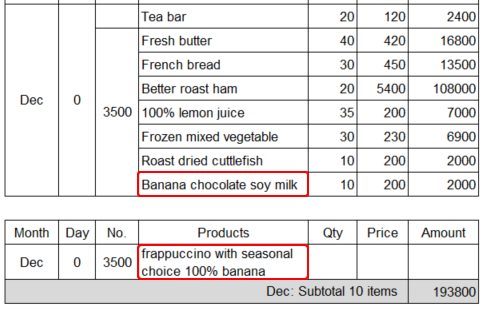 |
3 (extended auto link mode 3) | For the auto-link field in the record, only the part that does not fit within the page will be output on the next page (same as 2). Note that header records will be output at the beginning of the next page if all of them do not fit within the page (same as 1). |
Caution
In Report Director Enterprise, settings for extended auto link mode are only enabled at spool time.
If you change settings for extended auto link mode after spooling and print, operation will still be based on the settings at the time of spooling.
Restriction
When the extended auto link mode is enabled and there are multiple auto link fields with different font sizes in the same record, even if the large fields overflow from the page, the small fields may be displayed. However, even when it can be displayed, the page break will be performed for the same number of rows for all fields in the record.

Auto link-fields and extended auto link mode are not supported in the case of the following settings:
Direction of a subform is "Horizontal"
Text direction of a field is "Vertical"
With extended auto link mode enabled, if you use auto link field, you can specify only limited values (0.5, 1, 2, 3, 4, 6, 8) for the vertical/horizontal magnification ratios even in the graphic mode.
FFEject
Set FFEject when you want to output the next page after a page break by key break when printing on both sides.
When a key break occurs on an odd page, the paper is ejected with the back side blank. When a key break occurs on even pages, the paper is ejected as it is.
Also, when the specified key is in a formcopy, processing of the remaining part of the formcopy frame is interrupted and then moved to the next page. After switching to the next page, the continuous formcopy process is resumed, and the content after the page break by key break is output. Because processing of the formcopy is interrupted, you can prevent an empty frame from being printed on the same page.
To set FFEject, enter "/{FFEject=1}/" in Comment for the field that is subject to key breaks.
FFEject is supported for all printer models.

Caution
You need to select Page break for the target field on the Report-writer tab.
If Page break is specified for multiple fields, and Clear page count is specified for one of those fields, FFEject is enabled only for that key.
For file output printer models, only interruption of the formcopy is performed.
Specify a search field
When Data type of a field is set to "Text", use the following procedure to set a search field name. The procedure and dialogs that appear vary between the basic mode and the graphic mode.
Click the ... button in the Search field field.
In the graphic mode, skip this step.
In the Search field dialog, select a search field name and click the Edit button.
In the Edit dialog box, enter Search field name.
In the Search field dialog, you can cut out a part of the value output to a field or convert text-type data into numeric-type data or date-type data.
Buttons in the Search field dialog have the following meaning:
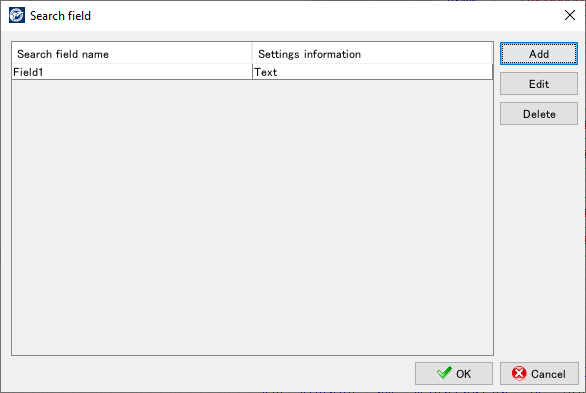
Item | Description |
|---|---|
Add | Add when cutting out part of field value and setting multiple search fields. When multiple information is output in one field, the divided data can be used as a search condition. Click to display the Add dialog. |
Edit | Edit when changing the search field name or converting character type data to numeric type or date type. Click to display the Edit dialog. |
Delete | Deletes the selected search field. |
The items you can set in the Add and Edit dialogs are the same.
The setting items in the Add and Edit dialogs are as follows:
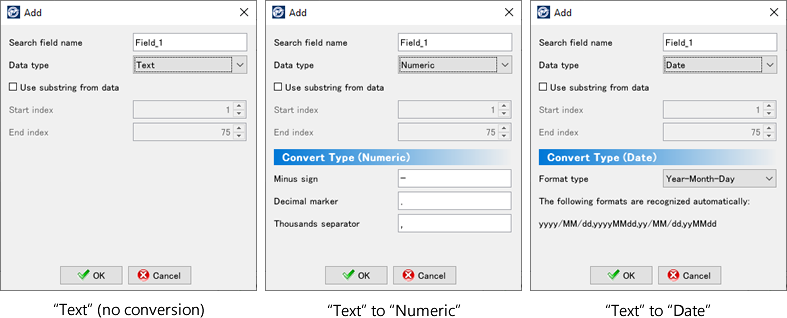
Item | Description | ||||||||||||||||||
|---|---|---|---|---|---|---|---|---|---|---|---|---|---|---|---|---|---|---|---|
Search field name | Specify a search field name. The same name specified in Name of the field is set as the initial value. You can use alphanumeric characters, Kana, Kanji, and underscores (_). Do not use a number for the first character of a search field name. Names with ten or more bytes of consecutive numeric characters cannot be used. The maximum length of the name depends on the setting in Preferences. | ||||||||||||||||||
Data type | Select the data type for converting character data to numeric type or date type from "Text", "Numeric", and "Date". If you select "Text", the data type will not be converted. If you specify "Numeric" or "Date", configure the type conversion settings in Convert Type (Numeric) or Convert Type (Date) that appears. | ||||||||||||||||||
Use substring from data (Basic mode only) | Specify whether to cut out the search target data by the index. When selected, you can specify Start index and End index.
| ||||||||||||||||||
Convert Type (Numeric value) | Specified symbols are recognized and converted into numeric-type data. Symbols that are not recognized as numeric data will be removed or converted. Specify for each symbol defined with the format of text data to be output to PDF.
| ||||||||||||||||||
Convert Type (Date) | Text data in the specified format is converted into date-type data. If any date function is specified in Calculation-formula or Edit-formula, specify the format of the processing result of the function.
|
